
A cave or cavern is a natural void under the Earth's surface. Caves often form by the weathering of rock and often extend deep underground. Exogene caves are smaller openings that extend a relatively short distance underground. Caves which extend further underground than the opening is wide are called endogene caves.
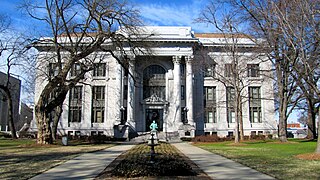
Hamilton County is a county located in the U.S. state of Tennessee. It is located in the southern part of East Tennessee on the border with Georgia. As of the 2020 census, the population was 366,207, making it the fourth-most populous county in Tennessee. Its county seat is Chattanooga, located along the Tennessee River. The county was named for Alexander Hamilton, the first secretary of the treasury. Hamilton County is one of 95 counties within Tennessee. Hamilton County is part of the Chattanooga, TN-GA Metropolitan Statistical Area. The county was created on October 25, 1819. Hamilton County expanded to meet the state line with Georgia after absorbing parts of three different counties including Bledsoe, Marion, and Rhea. Part of the traditional Cherokee homeland, the county was created after the Cherokee signed a treaty in 1817 with the United States and ceded land north of the Hiwassee River. In the 21st century, Hamilton County is the eighth-highest income Tennessee location by per capita income ($26,588).

The Natural Bridge Caverns are the largest commercial caverns in the US state of Texas. The name is derived from the 60-foot (18 m) natural limestone slab bridge that spans the amphitheater setting of the cavern's entrance. The span was left suspended when a sinkhole collapsed below it.

Blanchard Springs Caverns is a cave system located in the Ozark–St. Francis National Forest in Stone County in northern Arkansas, USA, 2 miles (3.2 km) off Highway 14 a short distance north of Mountain View. It is the only tourist cave owned by the United States Forest Service and the only one owned by the federal government outside the National Park System. Blanchard Springs Caverns is a three-level cave system, all of which can be viewed on guided tours.

Kartchner Caverns State Park is a state park of Arizona, United States, featuring a show cave with 2.4 miles (3.9 km) of passages. The park is located 9 miles (14 km) south of the town of Benson and west of the north-flowing San Pedro River. Long hidden from view, the caverns were discovered in 1974 by local cavers, assisted by state biologist Erick Campbell who helped in its preservation.

Inner Space Cavern is a karst cave located in Georgetown, Texas. The cavern was formed by water passing through Edwards limestone. The cavern is estimated to be around 20–25 million years old but were only open to the surface since the late Pleistocene period 14,000–45,000 years ago.
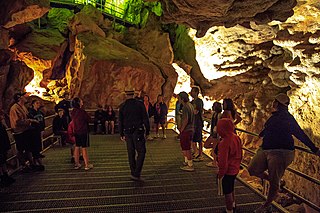
Jewel Cave National Monument contains Jewel Cave, currently the fifth longest cave in the world and second longest cave in the United States, with 220.01 miles (354.07 km) of mapped passageways as of May 2024. It is located approximately 13 miles (21 km) west of the town of Custer in Black Hills of South Dakota. It became a national monument in 1908.

Treak Cliff Cavern is a show cave near Castleton in Derbyshire, England. It is part of the Castleton Site of Special Scientific Interest and one of only two sites where the ornamental mineral Blue John is still excavated. As part of an agreement with English Nature, the Blue John that can be seen in the show cave is not mined but it is extracted in small quantities from other areas of the cave and made into saleable items like bowls, jewellery, and ornaments.

Cave of the Winds is a cave in the Pikes Peak region of Colorado. It is located just west of Colorado Springs on U.S. Highway 24, near the Manitou Cliff Dwellings. Tours of the complex of caves are given daily.
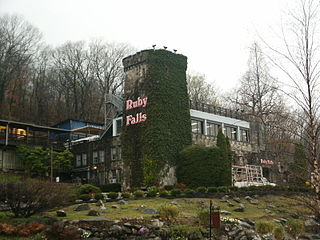
Ruby Falls is a series of underground cascading waterfalls totaling 90 feet (27 m) in Lookout Mountain, near Chattanooga, Tennessee, in the United States.
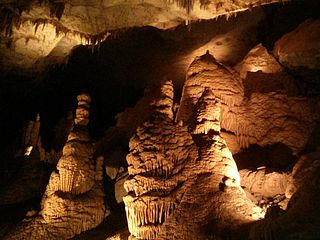
Cumberland Caverns is a national natural landmark and show cave located in McMinnville, Tennessee. It is the second longest cave in Tennessee and the twelfth longest cave in the United States.
Lookout Mountain Caverns is the second-longest known cave in Hamilton County, Tennessee. Its mapped length of 2.481 miles places it at 361st on the United States Long Caves List. Unofficially, anecdotal reports of cave expeditions have exceed 12 miles with legends exceeding 82 miles. The cave is closed and public access is forbidden.

Black Chasm Cavern is a cave in the hamlet of Volcano in Amador County, California.
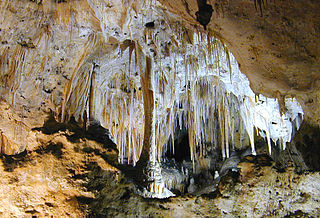
Carlsbad Caverns National Park is a national park of the United States in the Guadalupe Mountains of southeastern New Mexico. The primary attraction of the park is the show cave Carlsbad Cavern. Visitors to the cave can hike in on their own via the natural entrance or take an elevator from the visitor center.
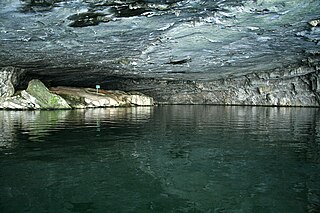
Nickajack Cave is a large, partially flooded cave in Marion County, Tennessee. It was partially flooded by the Tennessee Valley Authority's Nickajack Lake, created by the construction of Nickajack Dam in 1967. The entrance was originally 140 feet wide and 50 feet high. There is now about 25–30 feet of water at the entrance, so the portion of the entrance above water is 140 feet wide and 20–25 feet high. It houses a large colony of gray bats, an endangered species, and the water levels have posed a danger to the bat colony. The cave took its name from the Chickamauga Cherokee town of Nickajack, located between its mouth and the Tennessee River. The town was once attacked and destroyed in 1794 by the Nickajack Expedition.

Bluff Dweller's Cave is a show cave located just south of Noel, Missouri that was discovered in 1925 and opened to the public in 1927. The cave was formed in the Pierson Limestone during the Paleozoic Era. The cave's passages total over 4,000 ft in length, with two entrances beneath a limestone outcropping of the bluff.

Indiana Caverns is part of the Binkley Cave system near Corydon, Indiana.
Nesticus furtivus, the Crystal Caverns cave spider, is a species of true spider in the family Nesticidae. It is found only in Raccoon Mountain Caverns, formerly Crystal Caverns, a commercial cave in Chattanooga, Tennessee, United States.

Cave diving is underwater diving in water-filled caves. The equipment used varies depending on the circumstances, and ranges from breath hold to surface supplied, but almost all cave diving is done using scuba equipment, often in specialised configurations with redundancies such as sidemount or backmounted twinset. Recreational cave diving is generally considered to be a type of technical diving due to the lack of a free surface during large parts of the dive, and often involves planned decompression stops. A distinction is made by recreational diver training agencies between cave diving and cavern diving, where cavern diving is deemed to be diving in those parts of a cave where the exit to open water can be seen by natural light. An arbitrary distance limit to the open water surface may also be specified. Despite the risks, water-filled caves attract scuba divers, cavers, and speleologists due to their often unexplored nature, and present divers with a technical diving challenge.


















